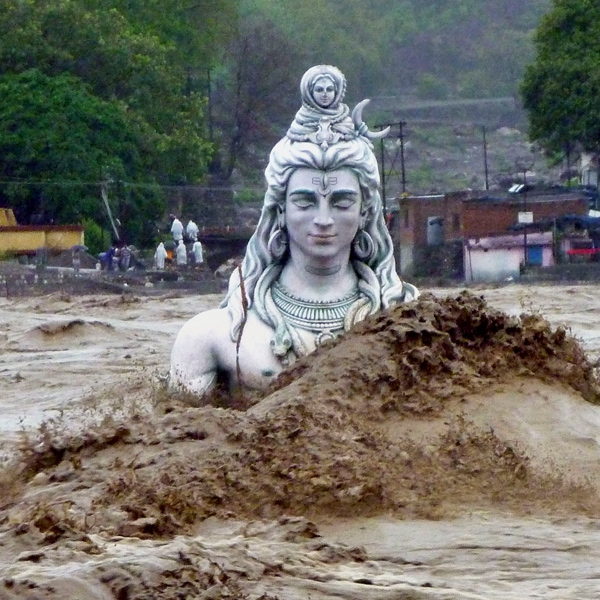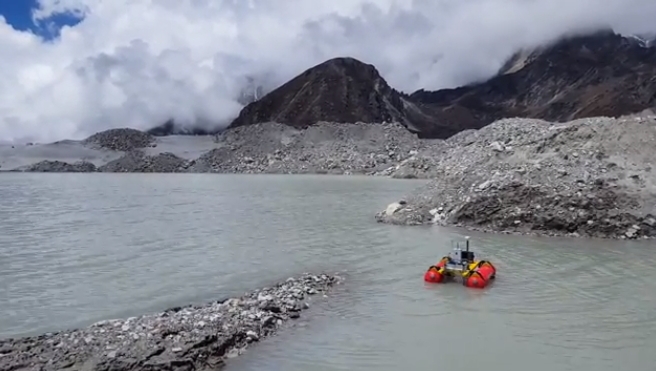
The Gojongbok Glacier in Nepal is the longest mountain glaciers in the Himalayas. There are hundreds of large and small lakes in the glacier basin. Global warming, rapid melting of glaciers, making the lake water level rise, every summer is the time of the outbreak of mountain torrents.
At the beginning of this summer's rainy season, within 48 hours, an ice lake released the equivalent of 40 Olympic swimming pools. What's worse is that these ice lakes are like cancers. They continuously erode the Himalayan glaciers from inside and further double the melting speed of the glaciers. As a result, the residents in the lower reaches of the valley were crippled and faced with increasingly frequent mountain torrents. The locals called these flash floods a "Himalaya tsunami."

Early knowledge of the occurrence of floods is extremely important to the downstream people, which requires the collection of more geological and hydrological information on these glacial lakes.
Scientist Ulyana is eager to find out how these ice lakes form and spread, how they connect to each other through secret underground passages, and the depth of the ice lake, the shape and composition of the lake bed.
However, ice lake is a dangerous place for human beings.
Even near the ice lake, it may cause unpredictable ice collapse. Not to mention entering the lake. If a group of people floats on an icy lake in an inflatable boat, huge ice or rocks will roll over the ice cliffs around the lake at any time. Breaking into the water threatens the lives of researchers. .
So Ulyana, along with colleagues and the local Sherpa group, recently began using automated swimming robots to map the topography of the lake bed and find glacial crevices that could trigger flash floods. Using robots to perform these mapping tasks is faster and more accurate than humans, and it allows researchers to avoid many potential hazards.

Researchers also work hard to find robots that can sneak in water, such as the OpenRov Trident dive robot shown below. The OpenRov Trident is tethered to the rope and can dive down to 100 meters below the water surface, with a top speed of 7 kilometers per hour and a battery life of 3 hours. Trident weighs less than 3kg and can be easily put into a backpack. The yellow cable is 25 meters long. If necessary, the length of the rope can be increased moderately. The robot can transmit captured images to the surface in real time, which can be used to map lakebed maps in a given area.

In addition, they are also using flying robots. Researchers set up an organization called WeRobotics in Kathmandu, Nepal. They cooperated with local university laboratories and other institutions to apply robots to humanitarian rescue operations. WeRobotics partners include the Rockefeller Foundation, DJI, Parrot, etc. The drone master Vijay Kumar is a member of their board of directors. At present, WeRobotics uses a lot of flying robots. They plan to integrate swimming robots and submersible robots in the future.

In economically underdeveloped areas, human beings will become more vulnerable to natural disasters due to lack of funds and technology. The introduction of advanced technologies such as robotics can help local people grasp the unpredictable "pulse" of the Himalayans and allow them to better survive in beautiful natural mountains and rivers.
Via National Geographic
Extended reading:
From the world's first single-bearing waveform robot to see how fast the rescue robot has developed. | 新智é€
After the earthquake in Italy, these disaster relief robots may help

Incremental Encoder,Linear Scale Encoder,Dual Concentric Rotary Encoder,Dc Servo Motor Encoder
Yuheng Optics Co., Ltd.(Changchun) , https://www.yhencoder.com